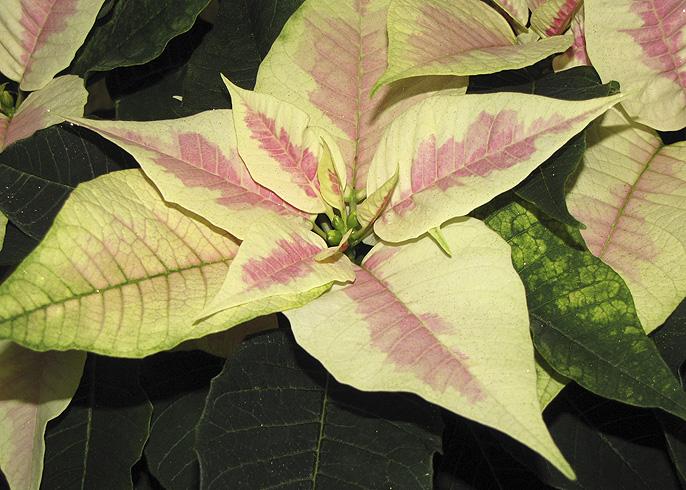
| Choose plants that appear strong and healthy. |
Purchase tips
Choose plants that appear strong and healthy. Check for signs of insects by looking at the underside of the foliage and avoid plants whose leaves are spotted or yellow. Next, check to see if the small yellow flowers are still on the plant. Remember, the red colour of the poinsettia is provided by modified leaves called bracts. The small yellow flowers should be located at the centre of the red bracts. Finally, never buy a plant that is displayed with a paper or plastic sleeve pulled right around the plant. The leaves will turn yellow and may fall off if the poinsettia was sleeved too long.
Taking your plant home
The garden centre where you purchase your poinsettia will provide the plant with some protection for the journey to your home. Never expose the plant to cold temperature for more than a few minutes; a chilled or frozen plant will drop leaves very quickly. When you have the plant at home, remove the protective wrapping immediately.
Taking care of your poinsettia
With proper care, your poinsettia will last through the holiday season and right into late winter. Play close attention to the following tips:
- Place in a room where there is bright natural light but not where the sun will shine directly on the plant.
- Keep the plant away from locations where it will receive hot or cold draughts.
- Place the plant high enough to be out of reach of unmonitored children and pets.
- Set the plant in a water-proof container to protect your furniture.
- Water the plant thoroughly when the soil surface is dry to the touch. Discard any excess water which remains in the saucer after 10 minutes.
- The bright colour of the bracts will remain longer if temperatures do not exceed 22°C.
If you cannot bear to throw your poinsettia out when it is finished providing colour, you may want to try your hand at reflowering your poinsettia next year.
| December | Full bloom. Water as needed. |
| April | Colour fades. Keep near sunny window and fertilize when new growth appears. Cut back stems to about 20 cm. |
| June 1 | Repot if necessary. Fertilize with a balanced formula 20-20-20. Continue to water when dry to touch. Move outside if temperatures do not fall below 10°C. Place in light shade. |
| Late August | Take inside. Cut stems back, leaving three or four leaves per shoot. Sunny window. Water and fertilize as needed. |
| Sept. 20 'til December 1 | Keep in light only from 8 a.m. to 5 p.m. Put in dark (NO LIGHTS) 5 p.m. to 8 a.m. |
Remember the key to success: Follow the strict light/dark instructions carefully.
Poinsettia plants
The botanical name for poinsettia is Euphorbia pulcherrima. The United States' first ambassador to Mexico, Joel Robert Poinsett, sent several plants back to his home in Greenville, S.C. in 1825. The poinsettia is not a poisonous plant. Research has proven that the poinsettia is not lethal to humans or pets unless eaten in extremely large amounts. However, your poinsettia and all other houseplants should be kept out of the reach of small children and pets, since varying degrees of discomfort may be experienced if plant parts are ingested.